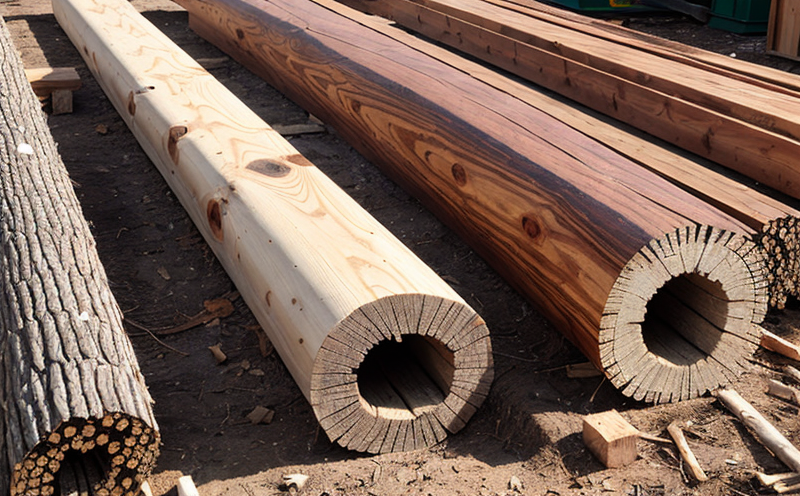Treated Wood Impact Resistance Testing
In the realm of agriculture and forestry testing, particularly within the category of wood durability and preservation testing, treated wood plays a pivotal role in ensuring structural integrity and longevity. Treated wood is subjected to various chemical preservatives or biocides to enhance its resistance against insects, fungi, and moisture-related degradation. One crucial aspect of assessing this treatment's effectiveness is through impact resistance testing. This service evaluates the ability of treated wooden materials to withstand mechanical impacts without compromising their durability.
The process involves subjecting wood specimens to controlled impacts using calibrated apparatus such as drop hammer testers or pendulum impact testers. The aim is to simulate real-world conditions where wood may be subjected to physical stress, whether from construction activities or environmental factors like accidental collisions. This testing not only ensures that the treated wood meets industry standards but also provides valuable insights into its performance under adverse conditions.
The specimens used in these tests are carefully prepared according to established protocols. Typically, they consist of standard-sized pieces of lumber that have been subjected to the same treatment process as the wood intended for use. By subjecting these specimens to predetermined impact forces and velocities, we can measure their resistance capabilities accurately. The results provide critical data on how well the treated wood holds up against potential damage, which is essential information for quality managers, compliance officers, R&D engineers, and procurement specialists involved in material selection.
Understanding the intricacies of this testing method requires familiarity with several key aspects including the types of impacts tested, the materials used, and the criteria for acceptance or rejection based on performance metrics. For instance, a specimen might be considered acceptable if it maintains its structural integrity after being struck multiple times within specified limits. Such tests help ensure that treated wood products meet not only regulatory requirements but also exceed expectations in terms of reliability and longevity.
In conclusion, Treated Wood Impact Resistance Testing is an indispensable tool for verifying the quality and durability of preservative-treated woods used across various applications in agriculture and forestry sectors. By leveraging this service, stakeholders can make informed decisions about material selection, thereby promoting sustainable practices that benefit both the environment and economic efficiency.
Applied Standards
| Standard | Description |
|---|---|
| ASTM D1436 | This standard specifies test methods for determining the resistance of wood and wood products to impact loading. |
| EN 928-1 | An equivalent European standard providing similar guidelines but tailored specifically for Europe's regulatory framework. |
| ISO 6709 | International ISO standard that offers comprehensive procedures for impact resistance assessment of wood products. |
Why Choose This Test
The decision to implement Treated Wood Impact Resistance Testing is driven by several compelling reasons. Firstly, it ensures compliance with stringent industry standards such as those outlined in ASTM D1436 and ISO 6709, which are widely recognized for their accuracy and reliability. By adhering to these guidelines, manufacturers can demonstrate that their products meet or exceed international benchmarks, thereby gaining a competitive edge in the market.
Moreover, this testing method provides valuable insights into the durability of treated wood under realistic conditions. Real-world applications often involve situations where wood may encounter significant mechanical stress due to various factors like construction activities, natural disasters, or accidental impacts. Impact resistance testing simulates these scenarios effectively, offering a clear picture of how well-treated wood can withstand such challenges.
From an economic perspective, investing in this service helps businesses avoid costly replacements and repairs by ensuring that treated wood products are robust enough to last longer without compromising their structural integrity. This not only reduces maintenance costs but also extends the lifespan of structures or components made from these materials, ultimately leading to greater cost savings over time.
Additionally, conducting such tests enhances reputation among clients who value quality and reliability in their suppliers. Demonstrating a commitment to rigorous testing procedures instills confidence in customers, fostering long-term relationships built on trust and satisfaction. Overall, choosing Treated Wood Impact Resistance Testing is a strategic choice that aligns with modern business practices focused on sustainability, efficiency, and customer satisfaction.
Customer Impact and Satisfaction
The impact of Treated Wood Impact Resistance Testing extends beyond mere compliance; it directly contributes to enhancing customer satisfaction by delivering high-quality products that meet or exceed expectations. When manufacturers invest in this service, they are essentially committing themselves to providing robust solutions designed to stand up against the toughest challenges faced by wood-based materials.
For instance, customers in the agricultural sector rely heavily on treated wood for fencing and structural supports where exposure to harsh environmental elements is common. By ensuring that these products pass rigorous impact resistance tests, suppliers can assure their clients of lasting performance, reducing concerns about premature failures or breakdowns. This translates into peace of mind for farmers who know they are investing in durable infrastructure.
In the forestry industry, similar considerations apply where treated wood is used in various applications ranging from temporary shelters to permanent installations. The ability to demonstrate compliance with recognized standards and successful passage through impact resistance testing adds value to these offerings, encouraging broader adoption among potential users.
Moreover, satisfied customers are more likely to become repeat buyers or recommend the supplier's services to others. Positive word-of-mouth recommendations can significantly boost brand loyalty and market share for companies offering reliable treated wood products. Thus, prioritizing this type of testing not only improves product quality but also strengthens business relationships by building trust among stakeholders.





